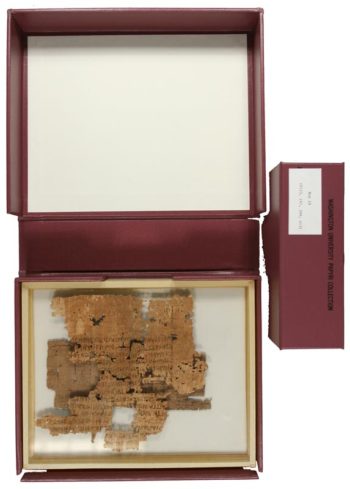Highlighting Washington University Libraries’ Papyri Collection
Although Washington University Libraries’ Manuscripts Collections are perhaps best known for their extensive Modern Literature Collection holdings from the 20th century, their oldest collections date back over two millennia. Some of the most ancient manuscripts you can find at Washington University are contained in a collection of 445 papyrus manuscript fragments dating from the 1st or 2nd century BC to the 7th century AD. The papyrus collection is owned by the Classics Department, but housed in Special Collections.
History of the Collection
In 1876, the English writer Amelia Edwards traveled to Egypt, a journey that she would later document in her travelogue A Thousand Miles up the Nile (1877). Fascinated by its historical artifacts and disturbed by the fact that they were being defaced and looted by tomb-robbers and tourists, she created the Egypt Exploration Society to explore ancient Egyptian sites and preserve and protect their cultural history.
The Egypt Exploration Society raised money for their preservation efforts by selling subscriptions. Washington University in St. Louis subscribed to the Society in 1922 for $100, through which it eventually obtained its collection of manuscripts.
Where Did They Come From?
The fragments in Washington University’s collection were excavated in 1923 by Sir William Flinders Petrie, one of the progenitors of modern archaeology. He found the fragments during an excavation of the ancient Egyptian city of Oxyrhynchus, one of the most important archaeological sites ever discovered.
Although some of the fragments contain written dates, most have been dated paleographically. Paleographical dating involves studying handwriting and finding patterns in the way letters were formed in different periods of time. It is not a perfect science, but papyrologists are generally able to approximate the date of a manuscript within a century or so.
Preserving the Fragments
The manuscript fragments are written on papyrus, a form of paper made from the stem of a large marsh plant that is native to the Nile Valley. The ink is made from soot mixed with a gum binder and is not water soluble, which has allowed it to last for thousands of years (in the right climate) without running or fading.
As some of the oldest and most fragile pieces in Washington University’s manuscript collections, many of these fragments are encased in glass to protect them from their natural enemies–mold and the brittleness of the material itself. In an interview with Off the Shelf (Fall 2007), retired preservationist Roxanna Herrick tells the following story about a challenge she faced in preserving papyrus:
What is Written on Them?
The fragments are from mainly non-literary items like official statements and accounts, deeds, leases, wills, receipts, correspondence, classroom writing exercises, but they also include fourteen literary and sub-literary texts like Homer’s Iliad, poetry and prose, religious rites, and commentaries.
Roughly a quarter of Washington University’s collection of 445 fragments has been published in a two volume set in a two-volume set Papyri from the Washington University Collection Parts I and Parts II and some have even been made available online.
Phillip Caprara, a graduate student in the Classics Department, is currently working on restoring and creating new translations for previously unpublished portions of the collection to make the collection more visible. Look for a special blog post highlighting Phillip and his work later this week!

